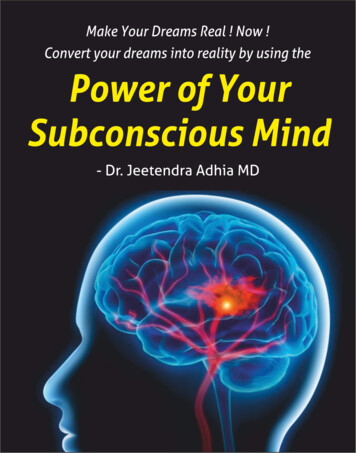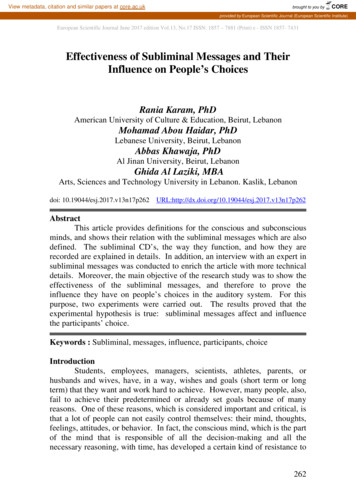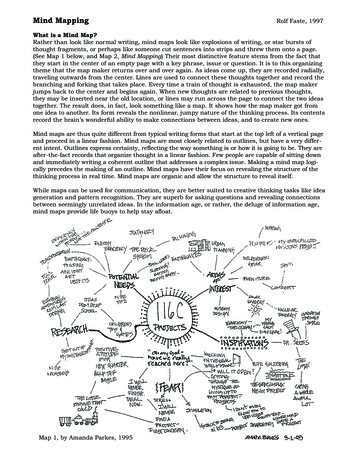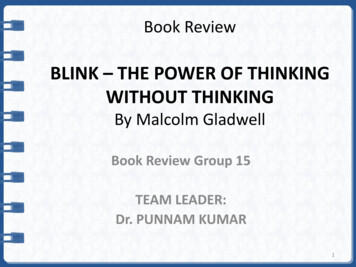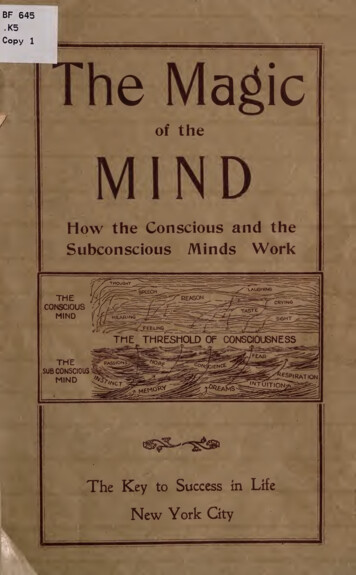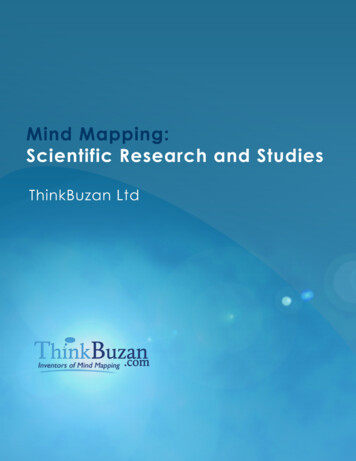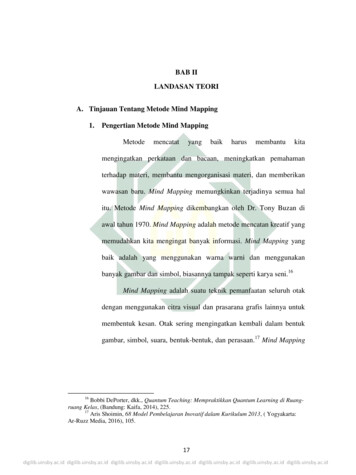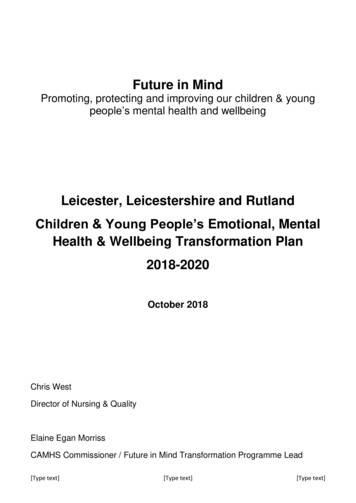
Transcription
Future in MindPromoting, protecting and improving our children & youngpeople’s mental health and wellbeingLeicester, Leicestershire and RutlandChildren & Young People’s Emotional, MentalHealth & Wellbeing Transformation Plan2018-2020October 2018Chris WestDirector of Nursing & QualityElaine Egan MorrissCAMHS Commissioner / Future in Mind Transformation Programme Lead[Type text][Type text][Type text]
Contents1. Future in Mind: Ambition for Leicester, Leicestershire & Rutland. 42. Forward . 53. Transformation Journey Summary of Progress. 74. Introduction . 85. Governance and Transparency. 96. Understanding Local Need. 10Leicester, Leicestershire and Rutland Population. 11Joint Strategic Needs Assessment (JSNA) . 12Participation of Children, Young People and Families . 14Tackling Health Inequalities . 17Working Together with Partners . 187. Local Transformation Plan Development . 208. Collaborative and Place Based Commissioning. 22CCG Commissioned Services . 23Local Authority Services . 23Co-Commissioned/Joint Services Delivered By Health & Social Care . 24Alignment between Future in Mind, Transforming Care Programme (TCP) and the SpecialEducational Needs and Disability (SEND) agenda . 249. Health Commissioned Services . 26Route to Resilience . 26Online Counselling . 27Early Intervention Service . 29Child and Adolescent Mental Health Services (CAMHS) . 31Community Eating Disorders . 32Crisis Resolution and Home Treatment (CRHT) . 33Early Intervention Psychosis (EIP) . 34Learning Disability Services Assertive Outreach . 35Family Action Post Sexual Abuse Counselling . 36Liaison Psychiatry. 37City Early Intervention Psychology Support (CEIPS). 3810. Local Authority Commissioned Services . 39Early Help . 39The Mistle Project . 40Final version for publication Nov 2018Page 2 of 70
11. Jointly Commissioned Services (Health and Social Care) . 40Young People’s Team . 40Youth Offending Service (YOS) . 41Family Support Service . 4212. Services in Development . 43Autism with or without a Learning Disability – Health Commission. 43ADHD – Health and Social Care Joint Commission . 44Triage and Navigation Service. 4613. Managing Transition into Adult Services . 4714. Alignment with iThrive . 4815. Workforce and CYP-IAPT . 5016. Developing Workforce Training & Development . 5317. Participation and Involvement . 5518. Mental Health Services Data Set (MHSDS) . 5619. Impact and Outcomes . 5820. Finance – Budget Allocation . 5921. Sustainability . 6022. Risks . 61Final version for publication Nov 2018Page 3 of 70
1. Future in Mind: Ambition for Leicester, Leicestershire &RutlandOur ambition is that children & young people will have access to the right help at the righttime through all stages of their emotional and mental health development.For this to happen, we have developed a whole system approach to delivering a range ofemotional, mental health and wellbeing services that meet all levels of need.We have engaged with children & young people and their families and all stakeholdersincluding education, social care, health, police, housing and justice. We have developed ashared work plan with key priorities and joint commissioning. We have improved theinterfaces between our agencies to reduce fragmentation in commissioning and servicedelivery so that organisational boundaries are not barriers to care.We continue to monitor progress and implementation of the Transformation Plan through ourmonthly Future in Mind meetings.“Better TogetherHelping the people of Leicester to have longand healthy lives”Final version for publication Nov 2018Page 4 of 70
2. ForwardThe last year has seen considerable progress in our delivery of a range of services to meetthe needs of local children & young people with emotional, mental health and wellbeingneeds. We have continued to engage with key stakeholders, including children & youngpeople themselves. We have demonstrated, through our partnership working, the benefits ofshared learning and harnessing our efforts towards a shared vision.The Transformation Plan has moved our focus away from traditional ‘tiered’ service modelsto thinking more strategically and identifying shared objectives. Our focus is now on thewhole system and bringing together professionals, children, young people and their familiesto achieve better mental health and wellbeing outcomes. Our progress in implementing theTransformation Plan is provided in this report. A key focus over the remainder of the Futurein Mind Programme (until 2020/21) is continued partnership working and delivering moreintegration and alignment of services across the pathway.The majority of newlycommissioned services are making good progress in delivering high quality support andinterventions.Our existing challenges in achieving system wide transformation and areas which we aredeveloping include: Developing stronger strategic links to other reforms such as Transforming Care Improving data flow through Mental Health Services Data Set (MHSDS) to triangulateinformation and improve intelligence on access and care and treatment. Increasing the number of schools engaged in Route to Resilience in year 2. InRutland, a separate resilience programme is being developed which may result induplication of efforts and schools disengaging in the current commissioned offer. To continue to enhance our online counselling offer to meet increased servicedemand. Current activity is significantly higher than our initial forecasted levels. To continue to enhance our Early Intervention Service to ensure workforce capacitycan meet service demand. The service is currently dealing with double the caseload,approximately 200 referrals each month. To develop the Eating Disorders Service and align this to the wider pathway ofservices to ensure referrals can be better managed, e.g. referrals can be directed toFinal version for publication Nov 2018Page 5 of 70
Crisis Resolution and Home Treatment or Early Intervention Service whenappropriate. There are an increasing number of Care and Treatment Reviews (CTRs) andemergency teleconference (Blue Light) meetings taking place for children and youngpeople. Funding has been secured to enable staff to provide intensive home support,on-going help and case management and co-ordination of on-going care. To develop our joint commission for ADHD solutions to decrease fragmentation withinthe service Developing an integrated referral management system that provides a central hub forhealth referrals. To continue to work with CAMHS to monitor existing waiting lists and gain assurancearound the service improvement action plan To identify opportunities for better utilisation of resources and commissioning servicesto meet levels of need across Leicester, Leicestershire and Rutland.In 2019/2020, we will develop and commission a Triage and Navigation Service with ourpartners, which will improve children & young people’s access to services, getting them tothe right service to meet their needs much quicker. We also anticipate that this service willfree up clinician time so their attention can remain focussed on delivering the right care andspecialist interventions needed.Where there are opportunities to develop our existing service, for example Trailblazer forMental Health Support Teams in schools or other developmental programmes, we willpursue these. We remain committed to enhancing services within our existing pathway toenable closer working with schools and colleges in the delivery of evidence basedinterventions.We continue to explore opportunities to enhance our pathway of services and to utiliseresources efficiently. This will contribute to sustainability.We have started work on our Workforce Development Strategy and are developing plans toincrease our workforce capacity and capability in line with national and local targets.Final version for publication Nov 2018Page 6 of 70
3. Transformation Journey Summary of ProgressFigure 1: Our Transformation Journey so far 2015-20202015-16 Developed LLR Transformation Plan Established governance structure andpartnership working arrangements Reviewed extsing service provision Agreed and established 6 schemes ofwork Improving resilience Enhanced Early Help Improved access to specialist childrenand adolescent mental health services(CAMHS) Enhanced Community Eating DisorderService: Developed a childrens crisis and hometreatment service Developed the workforce2016-172017-18 Strengthened partnerships approachand governance Designed services to meet local gaps inprovision Focus on a whole system approach &one pathway of care agreed at jointpartnership event Delivered: Enhanced Community EatingDisorder Service Enhanced Access to CAMHs Crisis and Home Treatment service Additional services planned anddesigned with partners; for examplework with schools to help buildresilience in children and young people,provision and access to on-linecounselling and provision of a servicewhich could provide lower levelintervention and support for those thatdo not require specialist treatment. Services commissioned to providesupport for those with less complex orlower level need. Delivered: Resilience in schools programme Online Counselling Early Intervention Service Workforce Development PartnershipGroup established to oversee deliveryof a shared Workforce DevelopmentStrategy Participation & Involvement Networkestablished to improve opportunities forpartnership working and engagementwith children and young people Data Flow group established Data from 75% of commissionedservices/ providers being submitted tothe national mental health servicesdata set (MHSDS)Final version for publication Nov 2018Page 7 of 702018-21 With key partners deliver a wholesystem approach to assessment andcare,with greater 'common language'and understanding across differentsectors and providers Improve access to the emotional,mentalhealth &wellbeing pathway for childrenwho are 'looked after', for troubledfamilies and for those with SEND. Continue to involve, engage andconsult with C&YP as well asstakeholders and partners to shapelocal services. To increase the number of services andproviders that submit data to thenational MHSDS To work in partnership to improveprovision and access to ADHD pathway Autism pathway Health & Justic pathways Improve access tp specialist CAMHS To work in partnership to improveyoung peoples during preparation foradulthood
Planning & Delivery of the LocalTransformation Plan 2015-20204. IntroductionThe Department of Health’s Task Force Report, “Future in Mind: Promoting and Improvingour Children & Young People’s Mental Health and Wellbeing” (DH, 2015) looked at how tomake it easier for children & young people to access help and support when needed andto improve how mental health services are organised, commissioned and provided. As aresult NHS England (NHSE) published a national ambition for how to transform children &young people’s emotional, mental health and wellbeing services.In 2015, health and care organisations in Leicester, Leicestershire and Rutland (LLR) setout on a five year journey to improve and transform the mental health and wellbeingservices for our local children & young people.Sustainability and Transformation Plans (STPs) were announced in NHS planningguidance published in December 2015. NHS organisations and Local Authorities indifferent parts of England worked together to develop ‘place-based plans’ for the future ofhealth and care services in their area. In LLR, draft plans were produced in June 2016and 'final' plans were submitted in October 2016.Our LLR Transformation Plan encompasses the 3 Clinical Commissioning Groups and the3 Local Authority Health and Wellbeing Boards: Leicester City Clinical Commissioning Groupshttps://hisservicedesk.leicestershire.nhs.uk West Leicestershire Clinical Commissioning Grouphttps://www.westleicestershireccg.nhs.uk/ East Leicestershire and Rutland Clinical Commissioning k/ Rutland County Councilhttps://www.rutland.gov.uk/Page 8 of 70EEM – Final Version LLR Local Transformation Plan 2018-2020
Leicester City Councilhttps://www.leicester.gov.uk/ Leicestershire County Councilhttps://www.leicestershire.gov.uk/The Transformation Plan reflects the 5 Year Forward View Plan (5YFVP) for MentalHealth Services Principles: Co-production with people with lived experience of services, their families and carers Working in partnership with local public, private and voluntary sector organisations,recognising the contributions of each to improving mental health and wellbeing Identifying needs and intervening at the earliest appropriate opportunity to reduce thelikelihood of escalation and distress, and support recovery Designing and delivering person-centred care, underpinned by evidence, whichsupports people to lead fuller, happier lives , and Underpinning the commitments through outcome-focused, intelligent and data-drivencommissioning.The Transformation Plan is aligned with the local STPThere is a section for Children & Young People’s Emotional, Mental Health and Wellbeingin the STP, which summarises the ambitions of our Transformation Plan (Appendix 1 - TheChildren & Young People’s Emotional, Mental Health and Wellbeing section of the STP)5. Governance and TransparencyThe Transformation Plan has been developed in partnership with a wide variety oforganisations and involved children & young people’s services from across health, localauthority, voluntary and community sector, schools and colleges as well as police,contributing throughout the process of planning, implementing, and now the delivery andevaluation of services. The following stakeholders are represented in our Future in Mind(FIM) Steering Group: Leicester City Local Authority Director of Children’s ServicesLeicestershire Local Authority, Director of Children’s ServicesRutland Local Authority Children and Family Services DirectorPage 9 of 70EEM – Final Version LLR Local Transformation Plan 2018-2020
Leicester City Public Health ConsultantLeicestershire Public Health ConsultantDirector of Nursing & QualityLeicester City CCG Finance OfficerLeicester City CCG CAMHS and Future in Mind Transformation Lead.GP RepresentativeChildren & young people (through participation & involvement activity)From April 2018 a revised governance structure that supports the delivery of the nextphase of our Transformation Plan was established and is outlined in Appendix 2a & 2bFuture in Mind Governance.6. Understanding Local NeedNational data demonstrates that 325,000 children & young people were treated throughNHS commissioned community services in 2017/18.This is approximately 30.5% ofchildren & young people with a diagnosable mental health condition.By 2020/21, there will be a significant expansion to children & young people’s mentalhealth care. At least 70,000 additional children & young people are expected to receiveevidence based treatment, representing an increase in access to NHS-funded communityservices to meet the needs of at least 35% of those with diagnosable mental healthconditionsOur Transformation Plan is designed and built around the needs of our local children,young people and their families across Leicester, Leicestershire & Rutland (LLR) , thathave or may develop a range of emotional and wellbeing problems, requiring low levelmental health or specialist CAMHS services.In order to fully understand our local population, triangulation of information and dataavailable from a range of sources was completed and was correlated with feedback fromchildren, young people and their families from across LLR about their experiences of careand preferences for local services to meet their needs.The following section provides an overview of information which helped partners to betterunderstand the wide range of services offered locally and gaps in provision. Thissubsequently informed our understanding of local need.Page 10 of 70EEM – Final Version LLR Local Transformation Plan 2018-2020
Leicester, Leicestershire and Rutland PopulationThere are in the region of 250,000 children & young people up to the age of 18 acrossLeicester, Leicestershire and Rutland (LLR, Census 2011).Strong links have been shown between mental health problems in children & young peopleand social disadvantage, with children & young people in the poorest households beingthree times more likely to have a mental health problem than those growing up in morewell-off homes and parental mental illness is associated with increased rates of mentalhealth problems in children & young people with up to 66% of those whose parents have amental health problem, having mental health difficulties themselves.Across LLR we know: 1 in 10 children & young people will have a mental health disorder 1 in 20 children & young people will have a conduct disorders Approximately 3000 children & young people will experience emotionaldisorders Approximately 2000 women will experience adjustment disorders and distress(i.e. perinatal mental health). 1 in 6 adults will have a mental health disorderThe number of children from diverse and minority populations requires the transformationplan to be culturally aware and services designed and delivered which are accessible andculturally appropriate. Peer and parental support groups for these communities areparticularly beneficial.By increasing the range of services available locally across our pathway, we have made iteasier for children & young people to access services. Our objective is to help children &young people develop and build their emotional resilience, therefore reducing the numberof children & young people that go on to require specialist interventions but for those thatdo, to ensure they receive responsive evidence based treatment and interventions.The tables below provide the trajectories of children & young people with diagnosableconditions that are expected to need access to NHS-funded community services.Page 11 of 70EEM – Final Version LLR Local Transformation Plan 2018-2020
Table 1a: National trajectory of children & young people expected to access NHSfunded services2016CYP expected to receive treatment infrom an NHS-funded community MH 21,000service (national)At least 35% of CYP with adiagnosable MH condition receive28%treatmentfromanNHS-fundedcommunity MH service 30%32%34%35%Table 1b: Local trajectory of children & young people expected to access NHSfunded services2016CYP expected to receive treatment inLeicester, Leicestershire & Rutland4200from an NHS-funded community MHservice (local trajectory)20172018201920204500508854065565Joint Strategic Needs Assessment (JSNA)Evidence from the local JSNA, (Appendix 3) shows that 10% of children & young peopleunder age of 16 have a diagnosable mental disorder and many more have emotionalproblems which are not recognised. The most common mental health problems areconduct disorders, anxiety and depression and it is known that mental health disorders cancause distress and can have wide-ranging effects including adverse impacts oneducational attainment and social relationships, affecting life chances and physical health.The proposals within the JSNAs were informed by a range of data that has been gatheredover recent years across each local footprint. Commissioners have worked in partnershipwith public health colleagues to provide up to date holistic profiles of need. The localinformation in JSNA is used routinely to inform service improvements and design, (seeappendix 3) alongside additional public health data, social care data, service provider dataincluding hospital admissions, information and feedback from stakeholders and serviceusers. Local Healthwatch organisations supported engagement activities and have usedtheir contacts with children & young people (including young people’s groups) to gainvalue feedback and consider their experiences of services.Page 12 of 70EEM – Final Version LLR Local Transformation Plan 2018-2020
From the Leicestershire JSNA, we know that in an average class (approximately 30 youngpeople aged 15 years): 3 could have a mental disorder 10 are likely to have witnessed their parents separate 1 could have experienced the death of a parent 7 are likely to have been bullied 6 may be self-harmingIn 2015, an estimated 8.7%, of children and young people aged 5-16 years had a mentalhealth disorder in Leicestershire. This equates to nearly 8,000 children. A very smallproportion of children with a mental health condition require psychiatric hospital admission.Between 2011 and 2017, the rates for hospital admissions for self-harm for children andyoung adults, aged 10-24 years has been increasing, both nationally and locally.Leicestershire’s rate remains below lower than the England average. Young women aremore likely to self-harm than young men. Although there is a strong link between self-harmand suicide there is no local data to report this.Less than 25% to 35% of children and young people with a diagnosable mental healthcondition access support. Action is needed across a child and young person’s life courseand within the wider context of their lives. There needs to be a greater emphasis on mentalhealth promotion, prevention of mental health problems and early intervention. Identifyingemotional and mental health problems early will also help to ‘break the cycle’. Broadlyspeaking our approach incorporates both interventions to promote and protect mentalhealth, wellbeing and resilience and interventions to reduce the risk factors for mentalillness.Preventative interventions and strategies address adversity and trauma and particularlyprioritise those who have Adverse Childhood Experiences (ACEs). ACEs include: parentalseparation, domestic violence, sexual assault, mental illness, alcohol abuse/ drug use.For those children who end up requiring support for emotional and mental health issueswe have good systems of early identification and we are strengthening coherent referralpathways into support. The JSNA acknowledged a cross-system single point of access forreferral is required; this gap in service will be met through the development of the Triageand Navigation Service.Page 13 of 70EEM – Final Version LLR Local Transformation Plan 2018-2020
Priorities across our local pathways include strengthening the Future in Mind Programmes,including Kooth (online counselling), Early Intervention, Crisis Support and EatingDisorders Services.Participation of Children, Young People and FamiliesChildren, young people and their families and carers were involved in developing theTransformation Plan.Engagement events in 2014, held by Leicestershire County Council’s Public Healthdepartment and the findings at that time were that a high number of children & youngpeople experienced anxiety, anger, challenging behaviour including violence and selfharming and also raised issues surrounding bullying, family separation, domestic abuseand academic pressure, as causes of emotional and mental distress. The report identifieda rising number of issues relating to social media, including cyber-bullying, and internetsites or groups which promote self-harm or eating disorders.Children and young people have also said that they want to have the confidence to talkabout emotional problems openly and without stigma. They want to be able to findinformation and support from their school, college or youth service, and also from websitesand social media.Education services want to offer education and guidance for theirpupils, provide pastoral support and know where to access specialist assistance. Parents,young people and schools are all concerned about the impact of cyber-bullying.Further LLR engagement events occurred during January and March 2016 to capturechildren and service user views and enable the ‘voice of the child’ to be central to pathwaydevelopment and the schemes of work in the transformation plan. At these events aconsistent message was that children and young people were worried about bullying,increasingly via social media, peer and academic pressure as well as other issues.Children, young people and their families and carers also clearly expressed that theywanted more information and easier access to help and support.Page 14 of 70EEM – Final Version LLR Local Transformation Plan 2018-2020
Children & young people have also said that they want to have the confidence to talkabout emotional problems openly and without stigma. They want to be able to findinformation and support from their school, college or youth service, and also from websitesand social media.Education services want to offer education and guidance for theirpupils, provide pastoral support and know where to access specialist assistance. Parents,young people and schools are all concerned about the impact of cyber-bullying.An example of the feedback from children & young people:“I can get support to help me overcome emotional health and mental healthchallenges quickly and locally, without being stigmatised. I will have choice about the kindof help I would like. I and those who care for me will be listened to. I will be supported tobecome resilient and independent. With my consent, services will work together with meand my family to give me the best support. I will be involved in decision to reduce ortransfer my care.”Children & young people’s ambitions for services also included:“I can access trusted self-care advice when and where we like including websites,education settings, GPs and children’s centres. I can get support to help me overcomeemotional and mental health challenges quickly and locally, without being stigmatised. Iwill be able to make informed choices about the kind of help I would like.”In addition to engagement events, Leicestershire County Co
Future in Mind Promoting, protecting and improving our children & young people’s mental health and wellbeing Leicester, Leicestershire and Rutland Children & Young People’s Emotional, Mental Health & Wellbeing Transformation Plan 2018-2020 October 2018 Chris W
